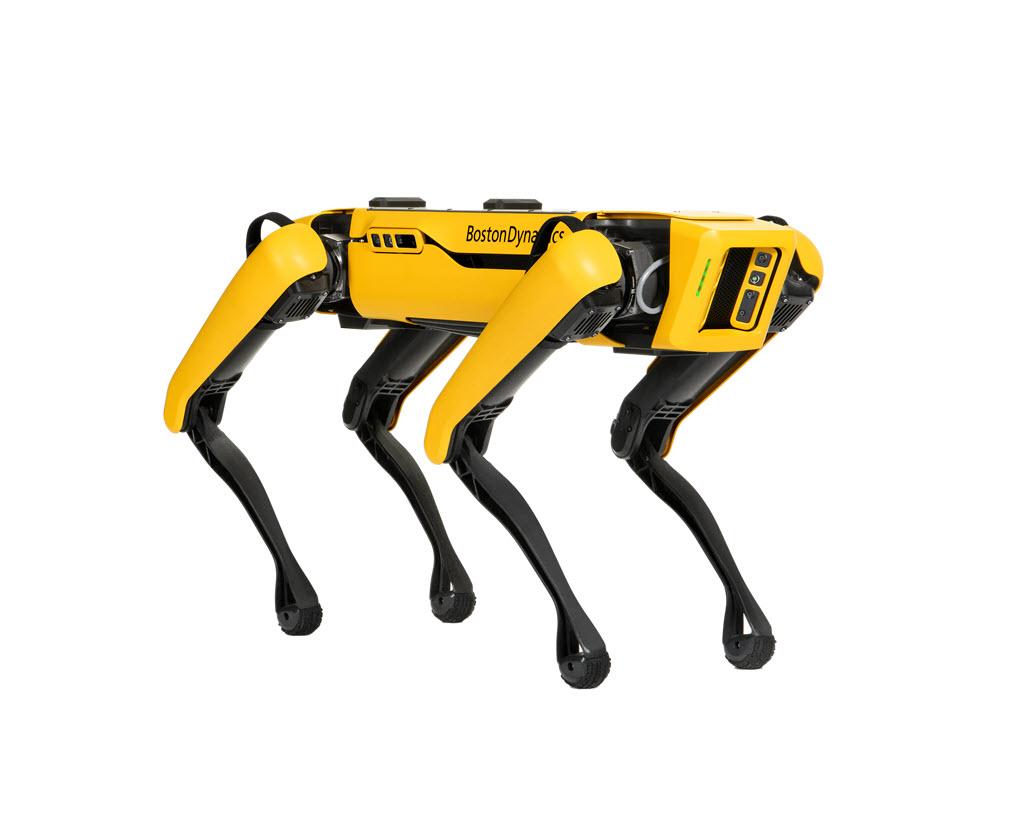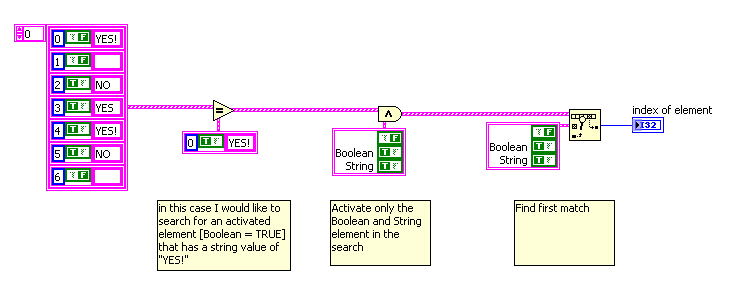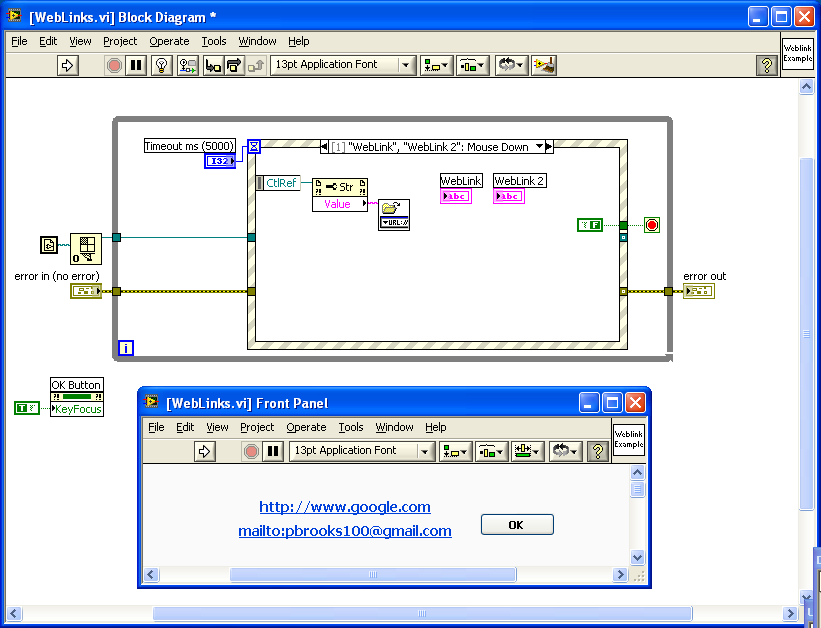
Phillip Brooks
-
Posts
911 -
Joined
-
Last visited
-
Days Won
53
Content Type
Profiles
Forums
Downloads
Gallery
Posts posted by Phillip Brooks
-
-
-
No because the error inputs are also not used in the terminals. I just put them there because maybe in the future I want to throw a error, then I will wire it. Now LabVIEW will just treat it as deadcode.
Be careful about error clusters that do nothing. I updated some low-level internal libraries a couple of years ago and had a bunch of developers get mad at me.
Basically, if you do add the error in / error out terminals to your connector pane for 'future use', make sure you place an Always Copy node on the Error wire or any caller could require a recompile if you make changes...
-
I don't have a setup to test this right now, but maybe try using Datasocket FTP functionality to write to the FTP server?
No Internet Toolkit, System Exec or windows security configuration required. The LabVIEW app and customer would use the same server and account.
UPDATE:
Just tried using DataSocket with the NI FTP site and received no LV error; the file name appears on the server, but I can't open it...
ftp://anonymous:pbrooks100%40gmail.com@ftp.ni.com/incoming/lavag.txt[text] [/CODE]
Note that I had to URL encode the @ in my email address as %40 because the @ is the separator between the user info and server name in RFC-1738
DataSocket FTP Write Example.vi (LV 8.6)
-
Is that lava flowing, or BBQ sauce?
-
This list of 10 things might make LabVIEW a bit nicer for me as an NI customer, but I see nothing that helps me make my product better for my users...
-
This 0 to 2^25 bit value ( 0 to 33554432) corresponds to 0 to 360. The manufacturer gave the following instructions to convert it into RPM.
Timed loop period to 1000 ms
Take difference of the current position value from the previous position value and divide it by 2^24 and multiply by 60.
I can read the current position. Then use the shift register on the timed loop to read the previous position value. Both are acquired using U64. When I subtract the two, the results fluctuates as below.
The difference, some random value, the difference, some random value, some random value, the difference.
One sample per second?
If your device is rotating at around 30 RPM you may see alternating signs in the difference (random values) when samples occur across the zero reference.
You could increase the sample rate and adjust your calculation accordingly, but may occasionally experience 'random' values whenever your samples occur over a zero crossing.
Create a shift register to store the sign of the last few differences. When the sign of the current difference doesn't match the previous values, add or subtract 2^25 to compensate for the zero crossing.
-
But that's part of the problem with the Idea Exchange kudos system; the top 10 ideas *are* low hanging fruits with minor impact already. The good ideas (as in; will significantly improve the power of LabVIEW and the products we can make with it) hide in the middle and even lower ranks.
I guess I should have defined low-hanging fruit as ideas that can be implemented with lower effort or scope on the part of NI.
I love simple things like the smaller T/F constant but I have to say that almost everything that has been completed is primarily IDE / cosmetic or a fix to a CAR. We did get a new feature that was of high value (thank you Stephen!)
The Idea Exchange is what, about three years old now? That gives us two cycles of reviewing suggestions, selecting, developing, testing and release.
What we've received is nice, but I'm concerned about features I mentioned before. If these are on the roadmap but might not make the next release cycle then please at the very least mark them as In Development. Then all you need to do is listen to me complain that I haven't seen any progress
 .
.Maybe NIWeek / LV 2012 will surprise me. (didn't have time to participate in the beta this year so I have no idea of whats coming)
-
Maybe you should post this on the Idea Exchange?

I would, but only a dozen or so people would vote for it and it would disappear like all the other GOOD ideas

-
I won't be at NI Week, but I had an idea.
What if NI were to take the top 10 or so ideas from the Idea Exchange and allow attendees to vote by show of hands, robot controlled ping-pong ball machine or stones in a pile.
The top voted idea would be assigned to a group and delivered in the next product cycle.
I feel lately that the only Idea Exchange entries that get any attention at all are the easy "low hanging fruit" ones.
Why not listen to the community more? I don't need VeriStand, a G to C Code generator or web based SilverLight tools.
I DO need things like SSL/SSH and Amish controls...
-
You can use the Open URL In Default Browser function and the Mouse Down Event for a string control.
-
You might be able to change the COM port assignment behavior by using one of the techniques in this document:
-
Sounds like a sourcender situation to me...

-
Congratulations!
-
 1
1
-
-
There appears to be a common perception that examples show the "right" way to do a particular task instead of "a" way to do the task.
Is there ever a "right way"?
I learned from my wife years ago that there is "her way" and the "wrong way".

-
I was suggesting that if the FTP progress is an issue, vote for my meager idea.
I had some off-line correspondence with NI folks regarding the SSH, but I'm more of a consumer and not qualified to provide the level detail that would be required. I still think this should be implemented in NI-VISA
 .
. -
There was a progress bar question on the NI forums a couple of years ago related to the FTP functions in the Internet Toolkit.
In that case, the file to be loaded was of an exact known size, but the function that transferred the file did not expose the bytes transmitted. Brute force suggestion to the poster was to use a global. A better solution would be to add a notifier that could be monitored for each file transfer session.
Vote for it if you use FTP, but what I'm really looking for is a total rewrite of the toolkit and native support for SSH/sFTP.
For a loader, the percent progress for loading a VI hierarchy could be approximated by knowing the number of VIs to be loaded and the current number in memory. As Aristos pointed out, the 99% issue exists when the last VI to be loaded happens to be the biggest (code size or data/memory allocation size).
-
No idea. Just assume LabVIEW was out for a night of heavy drinking and was hungover the next day. Dock its pay and put it back to work.
But NI week isn't until August...
-
 1
1
-
-
If your number of ports is more than eight, maybe you could use a terminal server instead. Our ESS setup uses two 16 port terminal servers to attach up to 32 UUTs via RS-232.
We have a mix of code that uses NI-VISA configured for a raw socket and/or use the Internet Toolkit Telnet VIs to the ports. We run from four to 16 hours using TestStand to execute command line tests on the UUTs. Our biggest problem to date has been the reliability/quality of the UUT diags...
Most terminal servers can be configured for 232/422/485 on a per-port basis. I haven't used any of the latest, but some include COM redirect drivers much like the USB-Serial devices to make interfacing easier...
-
Maybe use compare elements and then exclude the items you're not interested in; a variation of this:

http://lavag.org/topic/7335-wildcards-with-search-1d-array-prim/page__p__42656#entry42656
-
 1
1
-
-
This same code was posted on the dark side, and promoted on LinkedIn with the same link (below)
https://decibel.ni.com/content/docs/DOC-18612
Self promotion is fine, but spamming every possible forum with password protected code creates a negative impression of the poster (for me anyways).
-
I recall having some weirdness with "Get Text Rect" not working well with italic and bold fonts.
I ended up padding by +(x)% of the width to make things 'pretty'...
-
is anyone a member of the LinkedIn group that Martin mentions?
I am. I'll check it as soon as I have some free time...
-
 1
1
-
-
A great candidate for a <vi.lib> patch distribution from the LabVIEW Minutiae thread on the dark side:
http://forums.ni.com/t5/BreakPoint/LabVIEW-Minutiae-that-may-bite-you-someday/m-p/1973519#M19044
-
http://en.wikipedia....elated_software
Theis a C/C++ Interpreter that can be embedded into LabVIEW for Scripting.



LV 2012 Toolbar look
in LabVIEW General
Posted
It's in my profile.
We have so much code and libraries that we don't upgrade very often. The last upgrade happened when we went from 7.0 to 8.6 in December of 2008.
I try to participate in the betas and keep up on things, but I'm falling behind the times. I did download 2012 today, but won't do much with it until the end of the year. We might start our next project on 2012, the latest TestStand and win7